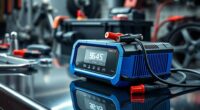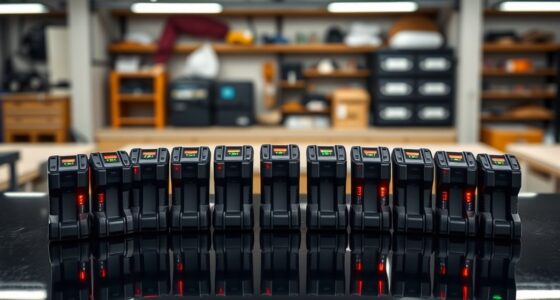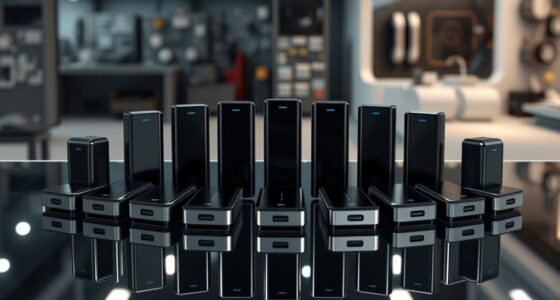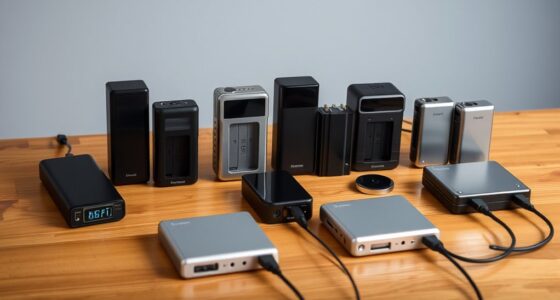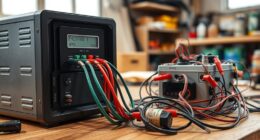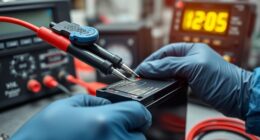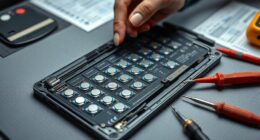If you’re looking to extend your lead-acid battery’s life and boost performance, I recommend checking out the top pulse desulfators available. These devices use high-frequency pulses to break down sulfate crystals, restore capacity, and improve starting power. From compact units to advanced models with LCD displays, they suit various applications and battery types. Keep exploring to discover more about these effective tools and find the best one for your needs.
Key Takeaways
- Support all lead-acid battery types, including flooded, AGM, GEL, VRLA, and EFB, for versatile application.
- Utilize advanced high-frequency pulse technology to effectively dissolve sulfate crystals and restore battery capacity.
- Offer automatic operation modes with safety protections like reverse polarity and overcurrent safeguards.
- Compact, lightweight designs with LCD displays and waterproof casings for easy installation and durability.
- Proven to extend battery lifespan up to five times longer by reducing sulfation and improving charge acceptance.
NEXPEAK NC201 10-Amp Battery Charger

If you’re looking for a versatile and reliable charger that can handle a variety of lead-acid batteries, the NEXPEAK NC201 10-Amp Battery Charger is an excellent choice. It supports 12V and 24V batteries, including AGM, GEL, SLA, and flooded types, making it suitable for cars, boats, motorcycles, and more. Its fully automatic 7-stage charging process assures efficient and safe charging, with features like reverse polarity protection, temperature compensation, and overcurrent safety. Plus, it doubles as a maintainer and desulfator, helping restore battery health and extend lifespan. Its user-friendly LCD display makes monitoring easy, making it a versatile tool for both home and professional use.
Best For: DIY enthusiasts, vehicle owners, and professional mechanics seeking a versatile, safe, and reliable charger for various lead-acid batteries across automotive, marine, and recreational applications.
Pros:
- Supports multiple battery types and voltages (12V and 24V, AGM, GEL, SLA, Flooded) for broad compatibility.
- Fully automatic 7-stage charging with safety features like reverse polarity, overcurrent, and temperature compensation.
- Functions as a maintainer and desulfator, helping to extend battery life and restore performance.
Cons:
- Cannot activate or fully charge batteries that are completely dead (0V).
- Requires some time for battery repair or desulfation, which may not be suitable for urgent charging needs.
- The LCD display, while user-friendly, may be limited in detailed technical information for advanced users.
Outerman Car Battery Charger, 12V-12A/24V-8.5AH Smart Automatic Battery Charger
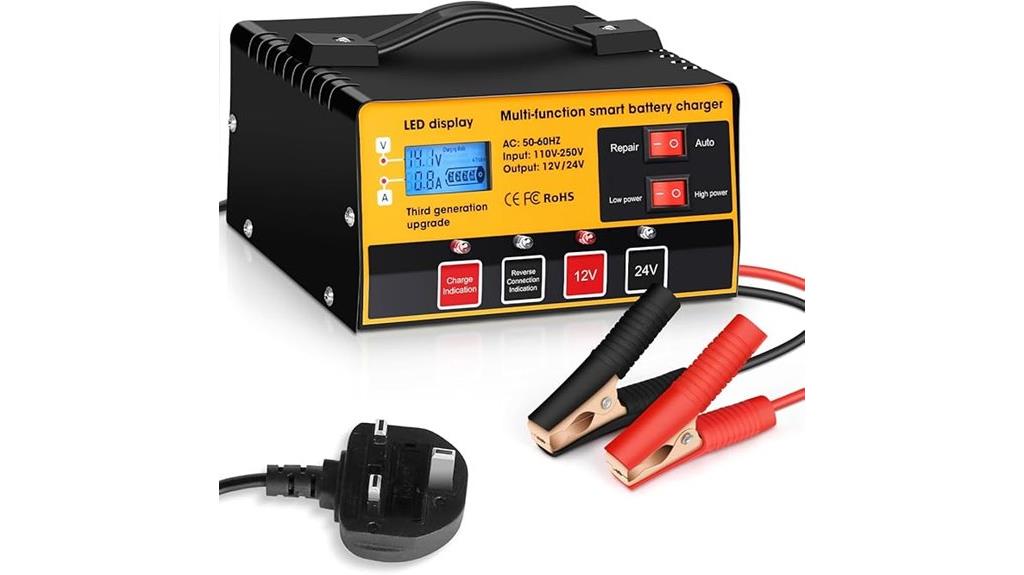
The Outerman Car Battery Charger stands out for its versatility and smart features, making it an excellent choice for vehicle owners who need reliable, automatic charging. It supports 12V-12A and 24V-8.5AH batteries, compatible with lead-acid, AGM, GEL, lithium, and marine types. Its compact, lightweight design and universal input voltage make it easy to use across different vehicles like cars, motorcycles, and RVs. The smart LCD display shows voltage and current automatically, while multiple modes—including repair and maintenance—ensure superior battery health. Despite some concerns about build quality and output consistency, users find it effective for restoring and maintaining batteries with minimal effort.
Best For: vehicle owners seeking an affordable, versatile, and automatic battery charger for various types of lead-acid and lithium batteries in cars, motorcycles, RVs, and marine applications.
Pros:
- Supports multiple battery types including lead-acid, AGM, GEL, lithium, and marine batteries.
- Features a smart LCD display that automatically shows voltage and current, with multiple modes like repair and maintenance.
- Compact, lightweight design with universal input voltage makes it easy to use across different vehicles and settings.
Cons:
- Some units may experience lower output performance (around 9.6A instead of 12A), possibly due to quality control issues.
- Metal construction and cables are susceptible to weather damage and corrosion if used outdoors.
- Build quality concerns and inconsistent performance may lead to reliability issues for some users.
20-Amp Car Battery Charger (12V/20A, 24V/10A) for LiFePO4 & Lead-Acid Batteries
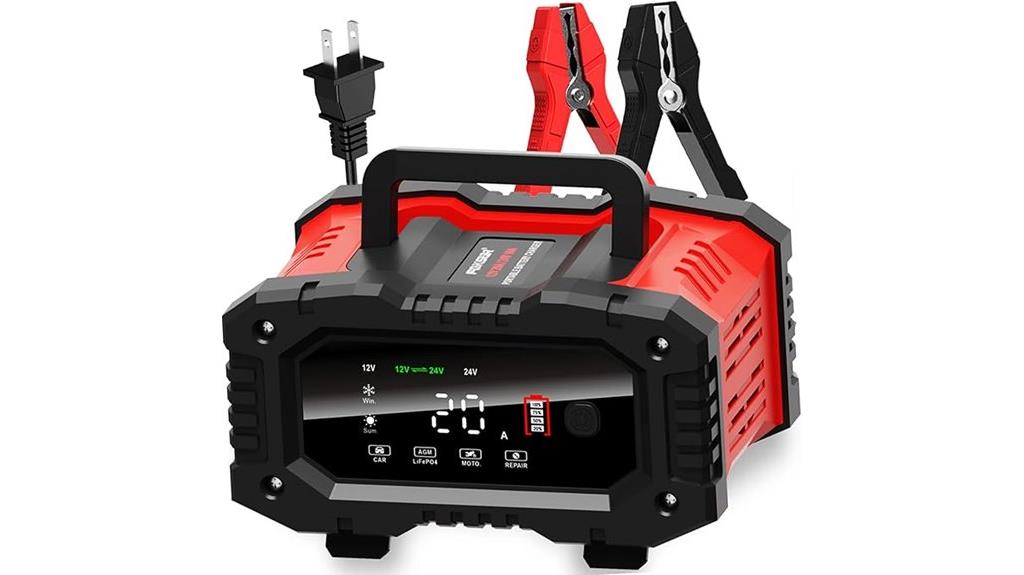
This 20-Amp Car Battery Charger is an excellent choice for vehicle owners seeking faster, reliable charging and maintenance for various battery types. It supports 12V/20A and 24V/10A outputs, compatible with lead-acid batteries (like AGM, GEL, SLA) and LiFePO4 batteries (with lithium disabled). Designed for automotive, marine, RV, and farm vehicles, it automatically detects battery voltage and performs desulfation to extend battery life. Its high-frequency transformer delivers quick, efficient charging, while the LCD displays real-time data. Built-in safety features protect against over-charge, over-voltage, and short circuits. Compact and user-friendly, it’s perfect for maintaining and reconditioning your batteries.
Best For: vehicle owners seeking a fast, reliable, and versatile charger for maintaining and reconditioning various lead-acid and LiFePO4 batteries across automotive, marine, RV, and farm equipment.
Pros:
- Supports quick charging with 20A (12V) and 10A (24V) outputs, reducing charging time.
- Equipped with advanced desulfation and pulse repair technology to extend battery lifespan.
- Features a user-friendly LCD display showing real-time voltage, current, power, and battery status.
Cons:
- Lacks an on/off switch, which may require unplugging after use.
- Limited to batteries that are not severely damaged or dead, as it cannot revive completely dead batteries.
- Some users reported occasional display issues, though overall functionality remains reliable.
Adjustable Battery Charger with LCD Display for 12V-72V Vehicles
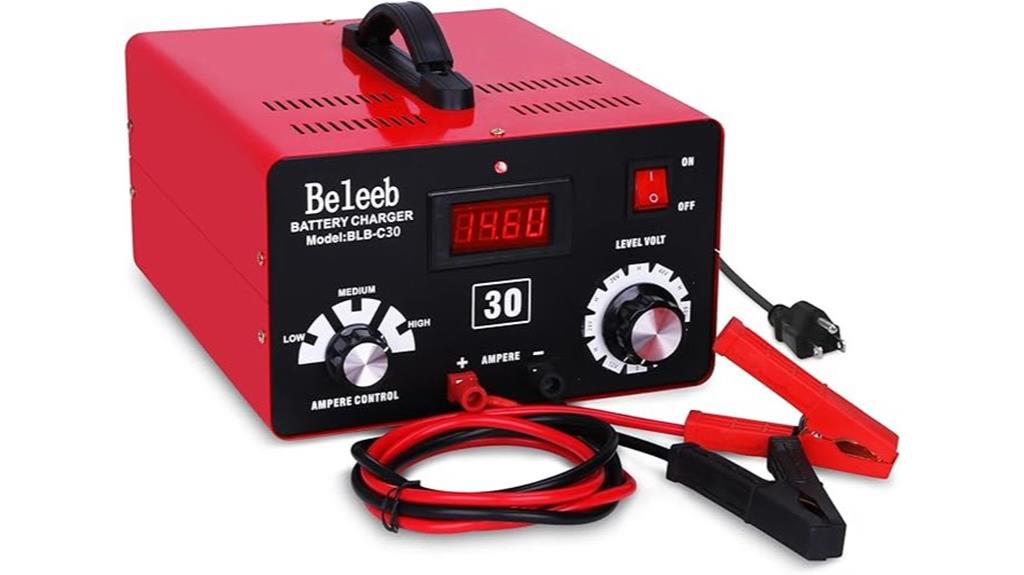
An adjustable battery charger with an LCD display stands out as an ideal choice for vehicle owners seeking precise control and real-time monitoring of their battery charging process. It supports a wide voltage range from 12V to 72V, compatible with various battery types like SLA, AGM, GEL, lithium, and deep cycle batteries. With dual modes—normal charging and pulse repair—it can restore and balance batteries, even reviving deeply discharged ones. Its smart design includes safety protections, adjustable speeds, and an easy-to-read LCD. This makes it perfect for maintaining, repairing, and extending the lifespan of batteries in cars, boats, RVs, and other vehicles.
Best For: Vehicle owners and maintenance professionals seeking precise, safe, and versatile battery charging and reconditioning solutions for a wide range of vehicles and battery types.
Pros:
- Supports a broad voltage range (12V–72V) compatible with multiple battery types, including lithium and lead-acid options.
- Equipped with dual charging modes and a battery repair function to restore and extend battery life effectively.
- Features intelligent safety protections, adjustable charging speeds, and an easy-to-read LCD display for user-friendly operation.
Cons:
- Some users have reported intermittent power issues related to AC circuit breaker connections.
- The device’s size and weight (approximately 20 pounds) may be less convenient for portable use.
- Minor damages during delivery have been noted by a few customers, indicating potential packaging concerns.
Pulsetech PowerPulse Battery Maintenance System
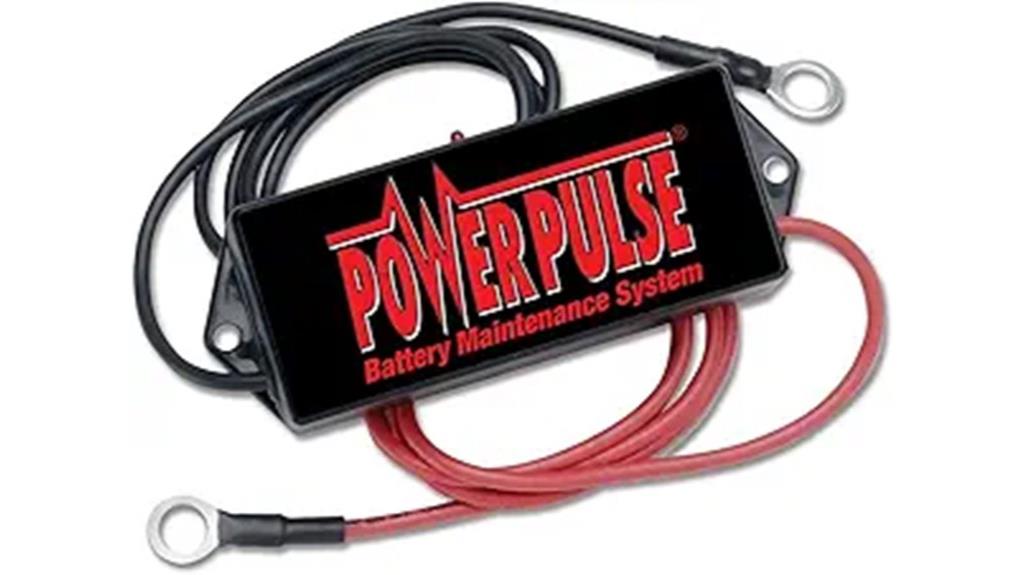
If you’re looking to extend your lead-acid battery’s lifespan and improve performance, the Pulsetech PowerPulse Battery Maintenance System stands out as an effective solution. This patented, stand-alone device works on all lead-acid battery types, including flooded, AGM, VRLA, and hybrid designs. It desulfates, maintains, and boosts charge acceptance, often extending battery life by up to five times. Many users report fewer replacements, better starting power, and faster recharges. It’s compact, easy to use, and can be stacked with other PulseTech products for various applications like trucks, tractors, and forklifts. Reputable sources and military agencies trust its proven technology.
Best For: individuals and businesses seeking to extend the lifespan and improve the performance of lead-acid batteries across various vehicles and equipment.
Pros:
- Significantly prolongs battery life, often up to five times longer than standard maintenance.
- Enhances charge acceptance and reduces sulfation buildup, leading to better starting power and faster recharges.
- Compact, easy to install, and compatible with all lead-acid battery types, supporting multiple batteries and stacking with other PulseTech products.
Cons:
- May not fully revive heavily damaged or heavily sulfated AGM batteries.
- Requires periodic vehicle operation or connection to a charger to maintain optimal performance.
- Not suitable for aircraft batteries or applications outside lead-acid battery technology.
200AH Lead Acid Battery Desulfator (12-48V)

For those managing 12V to 48V lead-acid batteries up to 200AH, the AH Lead Acid Battery Desulfator stands out as a highly effective solution. It targets sulfate buildup, a common cause of capacity loss and shortened lifespan, by using high-frequency pulses to break down lead sulfate crystals. Compatible with AGM, SLA, and VLRA batteries, it’s easy to use—detecting voltage automatically and protecting against reverse polarity. Users notice improved performance, longer battery life, and reduced charging times after just a few weeks. Its waterproof design and low energy consumption make it ideal for maintenance, storage, or recovering batteries from sulfation damage.
Best For: those with 12V to 48V lead-acid batteries up to 200AH seeking to restore capacity, extend battery life, and prevent sulfation issues.
Pros:
- Effectively reduces sulfate buildup, restoring battery capacity and performance
- Easy to use with automatic voltage detection and reverse polarity protection
- Waterproof design and low energy consumption make it suitable for various maintenance applications
Cons:
- Not suitable for batteries with severe structural damage or lithium-based types
- Limited effectiveness on full-size car batteries compared to smaller lead-acid batteries
- Requires periodic use (every four months) for optimal long-term results
12V-48V Battery Desulfator for Lead-Acid Batteries
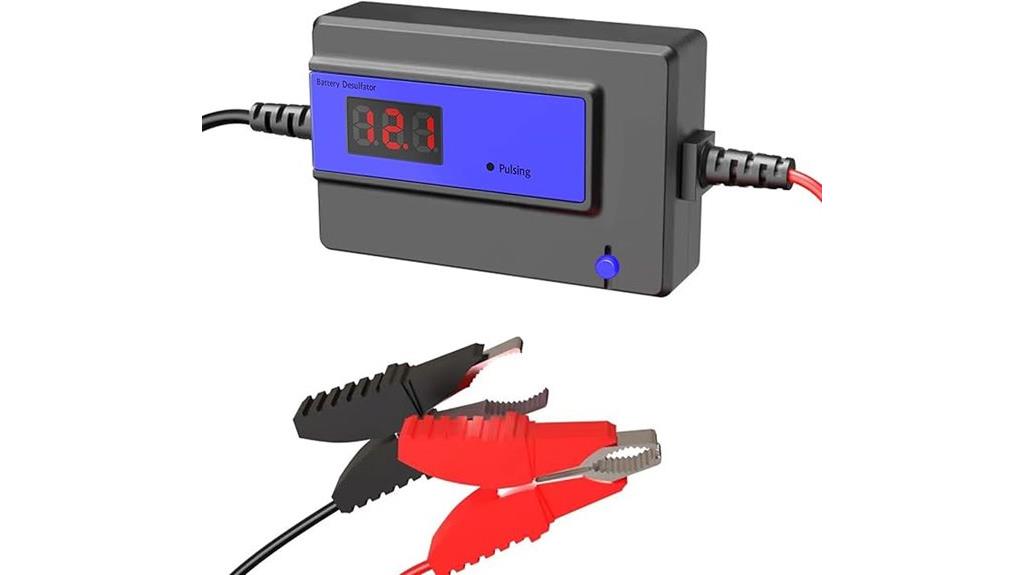
The V-48V Battery Desulfator is an ideal choice for those maintaining large lead-acid batteries in vehicles, boats, and farm equipment. It uses advanced high-frequency peak pulse technology to dissolve sulfates without damaging plates, helping extend battery life. Suitable for various types like AGM, GEL, EFB, and flooded batteries, it’s easy to use and effective over several weeks. Keep in mind, it’s not designed to fix severely damaged or dead batteries. Users report improved performance, better engine starts, and cost savings. Priced around $19, it’s an affordable way to maintain and restore your lead-acid batteries, provided they’re still chargeable.
Best For: individuals maintaining large lead-acid batteries in vehicles, boats, or farm equipment seeking an affordable, effective desulfation solution.
Pros:
- Uses advanced high-frequency pulse technology to safely dissolve sulfates and extend battery life.
- Compatible with various lead-acid battery types, including AGM, GEL, EFB, and flooded models.
- Easy to use with automatic operation, suitable for long-term maintenance and recovery.
Cons:
- Slow process that may take several weeks to show noticeable improvements.
- Not effective for severely damaged, dead, or electrolyte-depleted batteries.
- Limited features, such as basic voltage readings, and may require extended connection time for optimal results.
400AH Lead-Acid Battery Desulfator and Battery Maintainer
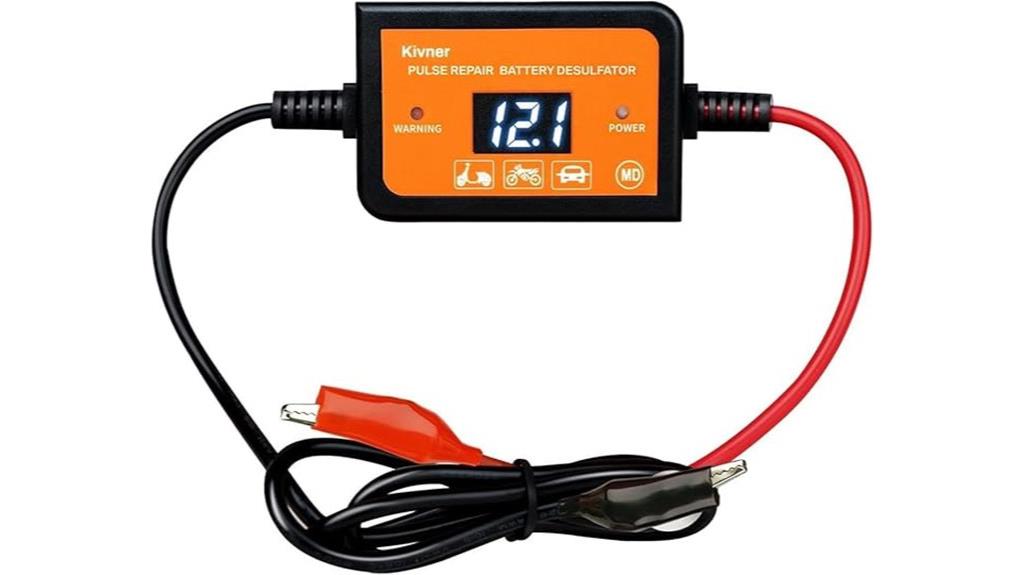
A 400AH Lead-Acid Battery Desulfator and Maintainer stands out as an ideal choice for those managing large, high-capacity batteries that require regular maintenance to prevent sulfation. It uses high-frequency peak pulse technology to break down lead sulfate crystals, restoring battery capacity and extending lifespan. Compatible with 12V-48V batteries up to 400AH, it automatically recognizes voltage and features reverse protection. The device can operate whether the battery is charging or idle, offering environmental benefits, shorter charging times, and improved performance. With simple operation, LED indicators, and a compact waterproof design, it’s an effective tool for maintaining large lead-acid batteries and preventing deterioration.
Best For: individuals or professionals managing large 12V-48V lead-acid batteries up to 400AH who need an effective maintenance solution to prevent sulfation and extend battery life.
Pros:
- Restores battery capacity and prolongs lifespan through high-frequency pulse technology
- Automatic voltage recognition and reverse polarity protection for safe operation
- Compact, waterproof design with easy-to-use LED indicators for convenient maintenance
Cons:
- Effectiveness may be limited on heavily sulfated or damaged batteries
- Some users report minimal visible improvements or persistent loud beeping
- Alligator clips can be small, requiring modifications for better connection
YONHAN 10-Amp 12V/24V Fully-Automatic Car Battery Charger

If you’re looking for a versatile and dependable charger that can handle various battery types and conditions, the YONHAN 10-Amp 12V/24V Fully-Automatic Car Battery Charger stands out. It works as a charger, maintainer, trickle charger, and desulfator, compatible with all lead-acid batteries like AGM, GEL, SLA, and Flooded. It features seasonal modes to optimize charging, plus a trickle mode for long-term maintenance. The backlit LCD displays essential info, and safety features like reverse polarity and overcharge protection ensure peace of mind. Its advanced repair mode can revive old batteries, making it a complete tool for extending battery life and performance.
Best For: vehicle owners and maintenance enthusiasts seeking a versatile, reliable, and safe battery charger capable of restoring and maintaining various lead-acid batteries across different seasonal conditions.
Pros:
- Compatible with all lead-acid battery types including AGM, GEL, SLA, and Flooded, providing broad versatility.
- Features multiple modes such as winter/summer adjustments, trickle, and repair, for optimal battery care and longevity.
- Equipped with safety protections like reverse polarity, overcharge, and short circuit prevention, ensuring secure operation.
Cons:
- Cannot charge batteries below 0.3V or batteries that are severely damaged or lithium-based.
- Requires proper connection and verification of battery voltage before use; not suitable for completely dead batteries.
- Limited output line length (65cm), which may require additional extension for some vehicle setups.
4A Lead-Acid Battery Desulfator
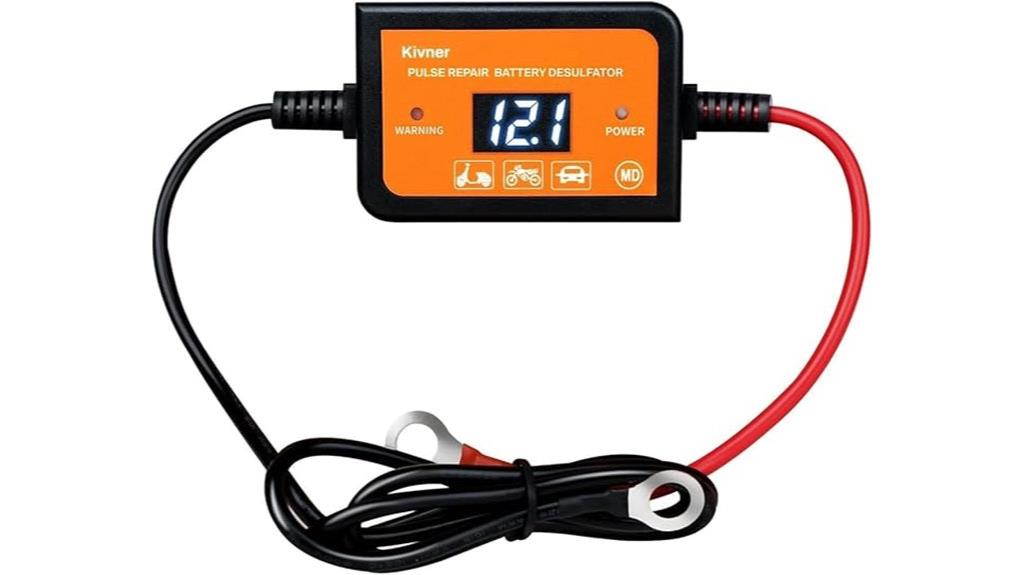
For anyone looking to extend their lead-acid battery’s lifespan and improve performance, a 4A pulse desulfator offers a reliable solution. This device targets sulfate crystals that form during repeated charge and discharge cycles, restoring capacity and reducing charging time. It works with batteries from 12V to 48V and up to 400AH, using high-frequency pulses to break down sulfation. Its safety features include reverse polarity protection and automatic voltage detection. Whether during charging or idle, it helps prevent battery deterioration, prolongs service life, and supports eco-friendly practices by reducing waste. Easy to connect and safe to use, it’s an excellent investment for battery maintenance.
Best For: battery owners seeking to extend the lifespan and improve the performance of their lead-acid batteries up to 48V and 400AH.
Pros:
- Effectively removes sulfate crystals to restore battery capacity and extend lifespan
- Safe to use during charging or idle, with reverse polarity protection and automatic voltage detection
- Environmentally friendly by reducing battery waste and supporting sustainable practices
Cons:
- May require 2-3 weeks to notice significant performance improvements
- Structural damage or severely damaged battery plates can prevent proper operation
- Needs proper initial testing of battery voltage before use to ensure compatibility
RoyPow 12V Battery Charger with Alligator Clamp and Ring Terminal
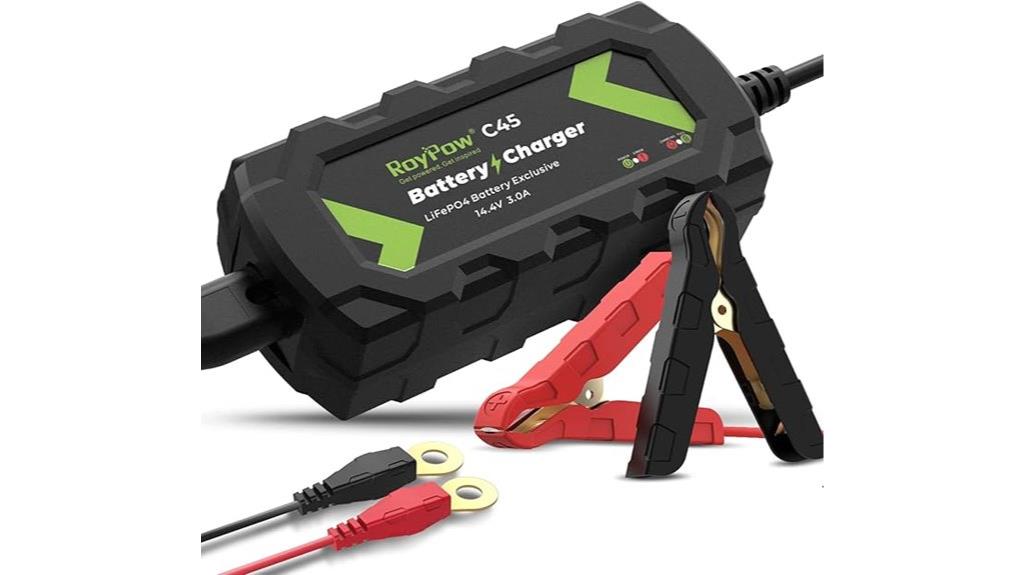
The RoyPow 12V Battery Charger with Alligator Clamp and Ring Terminal stands out as a versatile and user-friendly option for maintaining and reviving a wide range of 12V batteries. It’s compact, easy to operate, and acts as a smart maintainer, trickle charger, and desulfator all in one. The charger automatically switches to trickle mode once the battery is full, ensuring safe, hands-free operation. It supports various 12V lithium batteries, including lead-acid types, and can even revive dead or deeply discharged batteries. With built-in safety protections and lightweight design, it’s perfect for automotive, marine, or recreational use, providing reliable battery care anytime you need it.
Best For: DIY enthusiasts, vehicle owners, and marine or recreational users seeking a compact, versatile, and safe 12V battery maintenance solution.
Pros:
- Supports all 12V lithium, lead-acid, AGM, gel, and deep cycle batteries for wide compatibility.
- Automatically switches to trickle mode after charging, ensuring safe, hands-free operation.
- Equipped with multiple safety protections including short circuit, overload, and reverse connection safeguards.
Cons:
- May take longer to fully charge very deeply discharged or dead batteries.
- Limited to 12V batteries; not suitable for higher voltage systems.
- Basic features may lack advanced programming for specialized battery types or conditions.
NOCO GENIUS1 Smart Battery Charger (1A, 6V/12V)
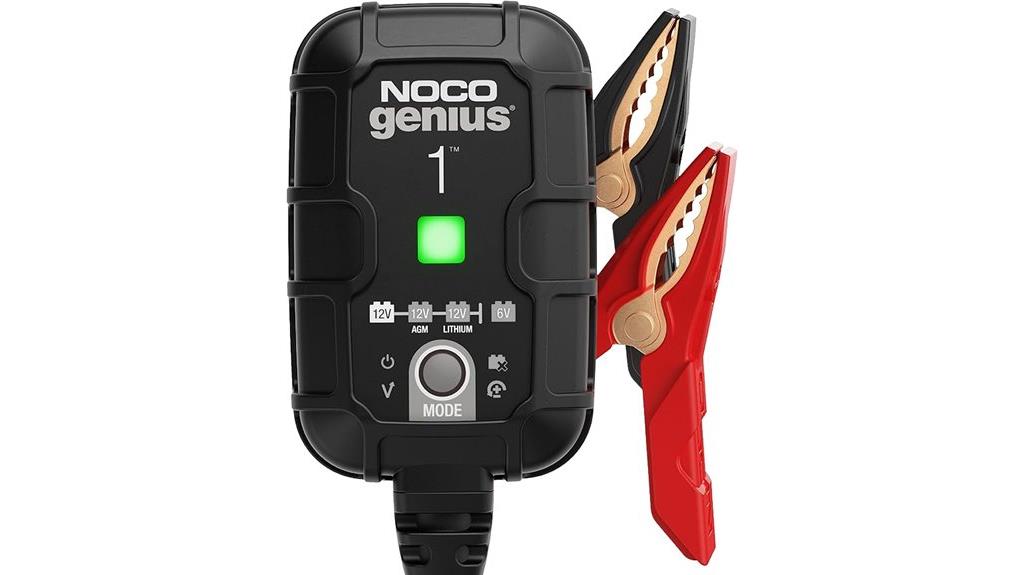
The NOCO GENIUS1 Smart Battery Charger stands out as a top choice for those seeking a reliable, all-in-one solution to maintain and restore their batteries. Compact and lightweight, it measures just 3.5 x 2.3 x 1.3 inches and weighs only 15.2 ounces. Designed in the USA, it supports 6V and 12V lead-acid and lithium-ion batteries up to 30 amp-hours. Its advanced features include temperature-adjusted charging with an integrated thermal sensor and pulse technology that reverses sulfation. Perfect for a wide range of vehicles and equipment, GENIUS1 guarantees safe, long-term maintenance, helping extend battery life without overcharging.
Best For: vehicle owners and maintenance enthusiasts seeking a compact, reliable, and safe battery charger and maintainer for long-term battery health and restoration.
Pros:
- Compact, lightweight design makes it highly portable and easy to store.
- Supports a wide range of batteries and vehicles, including lead-acid and lithium-ion types.
- Advanced features like temperature-adjusted charging and pulse desulfation improve battery lifespan and safety.
Cons:
- Not suitable for jump-starting dead batteries or quick recovery from fully discharged states.
- Initial setup can be confusing due to limited instructions and trial-and-error operation.
- Charging from a completely dead battery may take an extended period, up to two weeks.
KONNWEI 3-in-1 Car Battery Charger and Tester
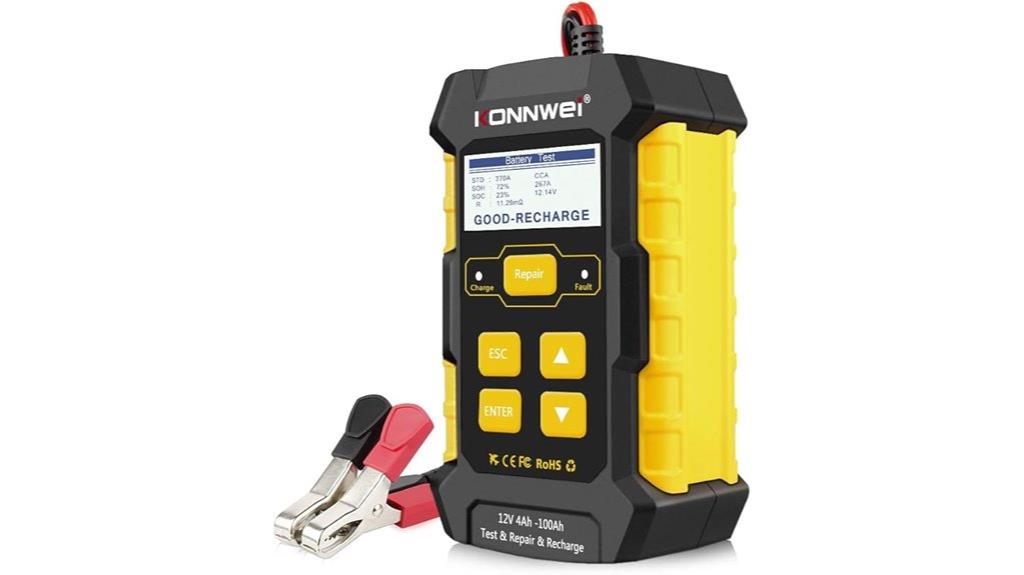
If you’re looking for a versatile tool that combines testing, charging, and repairing your vehicle batteries, the KONNWEI 3-in-1 Car Battery Charger and Tester stands out. It’s a compact device with a large color LCD display and easy-to-use controls, making battery maintenance simple. It supports all 12V lead-acid batteries, including flooded, AGM, and gel types, perfect for cars, boats, and lawnmowers. The KW510 provides detailed battery health analysis, runs accurate tests on voltage and internal resistance, and features pulse repair technology to reverse sulfation. Fully automatic and safety-protected, it’s a reliable all-in-one solution to boost your battery’s performance and lifespan.
Best For: vehicle owners and DIY enthusiasts seeking an all-in-one solution for testing, charging, and repairing 12V lead-acid batteries in cars, boats, and lawn equipment.
Pros:
- Combines multiple functions (tester, charger, repair) into one compact, easy-to-use device.
- Supports a wide range of 12V lead-acid battery types, including flooded, AGM, and gel.
- Equipped with a large color LCD display and safety features for user convenience and protection.
Cons:
- Limited to 12V lead-acid batteries; not suitable for lithium or other battery chemistries.
- May be less effective on heavily sulfated or damaged batteries that require professional intervention.
- Slightly higher price point compared to basic chargers due to its advanced features.
6V and 12V Car Battery Charger (15A)

A 6V/12V car battery charger with a 15A output stands out as an excellent choice for those needing fast, reliable charging and desulfation for a variety of lead-acid batteries. It’s versatile, supporting flooded, GEL, AGM, and EFB types, with capacities from 6Ah to 200Ah. Its automatic 8-stage process detects voltage, charges quickly, then switches to float mode to prevent overcharging. It also features pulse repair to de-sulfate and restore battery performance. Built with safety protections like reverse polarity and over-temperature safeguards, it’s durable and easy to use. While some manual instructions are lacking, its overall efficiency makes it a solid option for vehicle, boat, or lawn equipment batteries.
Best For: vehicle owners and maintenance enthusiasts seeking a fast, reliable, and versatile charger for various lead-acid batteries in cars, boats, motorcycles, and more.
Pros:
- Supports multiple lead-acid battery types (flooded, GEL, AGM, EFB) with capacities from 6Ah to 200Ah
- Features an automatic 8-stage charging process with float mode to prevent overcharging
- Includes pulse repair to de-sulfate batteries and restore performance
Cons:
- Poorly written manual instructions can make operation confusing for some users
- Automatic voltage detection may misidentify some batteries or fail with voltages below 8V
- Lacks an on/off switch, relying solely on plug-and-play, which may be less convenient for some users
12V Lead-Acid Battery Desulfator with POL Protection (Green)

For those seeking a reliable solution to extend their lead-acid battery life, the V Lead-Acid Battery Desulfator with POL Protection (Green) stands out. It automatically detects voltage and sends high-frequency pulses to dissolve sulfates, improving battery performance and longevity. Suitable for AGM, GEL, EFB, MF, Flooded, VRLA, SLA, and wet batteries, it’s ideal for batteries over six months old, up to three years. The device features reverse POL protection, easy-to-use interface, and real-time voltage display. While not for dead or damaged batteries, it effectively restores sulfated batteries, usually within 1-3 weeks, boosting reliability and engine start power.
Best For: individuals seeking to extend the lifespan and restore the performance of their lead-acid batteries, including AGM, GEL, EFB, and flooded types, especially those with batteries aged between six months and three years.
Pros:
- Automatically detects voltage and adjusts operation accordingly for ease of use
- Effective at dissolving sulfates to improve battery performance and reliability
- Safe with reverse POL protection and real-time voltage display
Cons:
- Not suitable for dead, severely damaged, or dried-out batteries
- Cannot repair lithium or non-lead-acid batteries
- Desulfation process takes 1-3 weeks, requiring consistent connection over time
Factors to Consider When Choosing a Pulse Desulfator
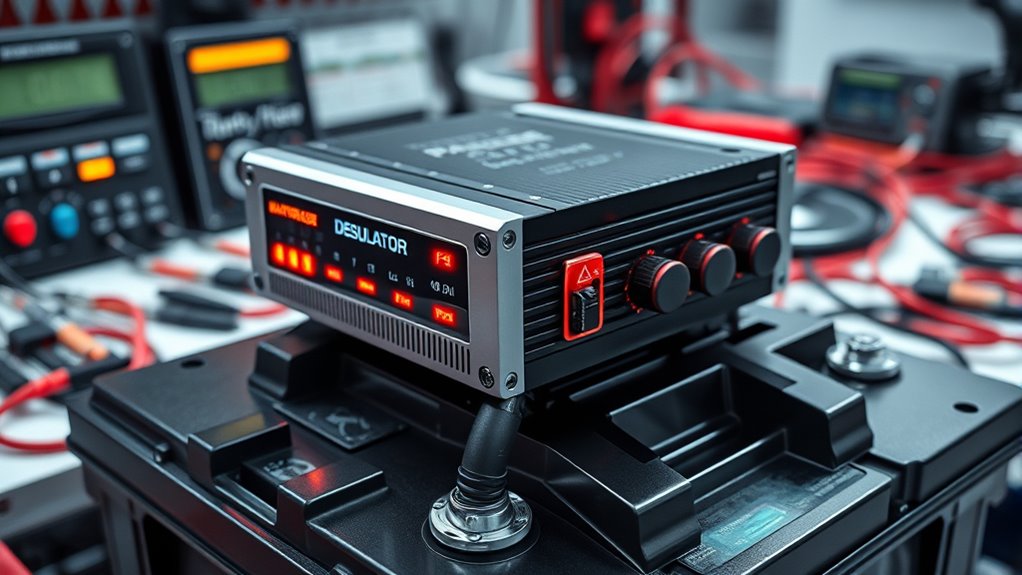
When choosing a pulse desulfator, I look at how well it matches my battery type and how quickly it can restore performance. Safety features are also a must to protect both the device and my batteries, while size and power needs influence where I can install it. Ultimately, ease of use saves me time and frustration, making the whole process smoother.
Compatibility With Battery Types
Choosing a pulse desulfator that matches your battery’s chemistry is crucial for effective sulfation removal and ideal performance. Different batteries, like AGM, GEL, flooded, or VRLA, require specific devices designed for their chemistry to work properly. Using a desulfator incompatible with your battery type can lead to poor results or even damage. Additionally, verify the device supports your battery’s voltage—whether 6V, 12V, or higher—to avoid mismatched output. Capacity matters too; pick a desulfator rated for your battery’s amp-hour size, typically up to 200AH or more, for effective treatment. Ultimately, consider your battery’s age and condition. Some desulfators work best on newer batteries with sulfation issues, while damaged or dried-out batteries may not benefit as much. Compatibility is key to safe, effective desulfation.
Desulfation Effectiveness and Speed
The effectiveness and speed of a pulse desulfator largely depend on the current sulfation level of your battery. Moderate sulfation responds best, while heavily sulfated or damaged batteries may see limited improvement. The pulse frequency plays a key role; higher frequencies (above 1MHz) typically break down sulfate crystals faster. Consistent use over time is vital—most batteries show noticeable gains after 2-3 weeks of regular pulsing. The type of technology also matters; high-frequency pulses usually decompose sulfate crystals more rapidly than low-frequency ones. Additionally, batteries with less advanced sulfation or in better condition tend to respond quicker to desulfation efforts. Overall, understanding your battery’s sulfation state and choosing a device with appropriate pulse technology can considerably impact how fast and effectively the treatment works.
Device Safety Features
Ensuring your pulse desulfator has the right safety features is crucial for both effective operation and long-term battery health. I always look for models with reverse polarity protection, so accidental incorrect clamping doesn’t cause damage. Overcurrent and overvoltage protections are essential to avoid stressing the battery or damaging the device during use. Temperature compensation features are a plus, as they adjust pulse intensity based on ambient conditions, preventing overheating or freezing issues. Automatic shutoff or over-discharge protection helps prevent overuse, which could harm the battery or the desulfator itself. Ultimately, I prefer devices with fireproof casings and durable construction, reducing risks of fire or electrical hazards over extended periods. Prioritizing these safety features gives me peace of mind and ensures a safer, more reliable desulfation process.
Power Requirements and Size
Matching the power requirements of a pulse desulfator to your battery is essential for effective sulfation removal. Make certain the desulfator’s power output aligns with your battery’s voltage and capacity, so it can deliver sufficient pulses without overload. Larger batteries need higher wattage or current capacity desulfators to work effectively, especially for deep-cycle or big setups. Additionally, consider the device’s size; it should fit comfortably within your installation space and match your wiring setup. Compact models work well for small batteries but may lack the power needed for larger ones. Always check the peak pulse current and voltage ratings to confirm the desulfator can safely handle your specific battery type and size. Proper matching guarantees maximum performance and longevity.
Ease of Installation and Use
Choosing a pulse desulfator that’s easy to install and operate can save you time and prevent frustration. Look for models with clear, simple connection instructions to guarantee correct setup without confusion. Devices that feature automatic voltage detection and intuitive interfaces, like LCD displays or indicator lights, make operation straightforward. It’s also wise to select a unit with built-in protections such as reverse polarity and over-current safeguards, which help prevent errors and damage. Ideally, choose a plug-and-play design that requires minimal setup, allowing you to quickly connect it to various battery types. Additionally, good documentation or accessible support resources can guide you through installation and maintenance, making the entire process smoother and more confident.
Durability and Build Quality
A pulse desulfator’s durability is essential for reliable performance, especially in demanding environments. A sturdy, waterproof, and corrosion-resistant casing helps it withstand harsh conditions, ensuring it functions over time. Using high-quality materials like heavy-duty copper wiring and robust enclosures enhances longevity and prevents breakdowns. Reinforced connections and secure clamps are crucial, as they resist wear from repeated use. Good durability also means resistance to thermal stress; components rated for high temperatures keep the device working reliably even under heat. Additionally, a solid construction with minimal moving parts reduces mechanical failure risks. When choosing a pulse desulfator, prioritize build quality, as it directly impacts the device’s lifespan and consistent performance, giving you peace of mind and better value in the long run.
Frequently Asked Questions
How Does a Pulse Desulfator Differ From Traditional Battery Chargers?
A pulse desulfator differs from traditional chargers because it targets lead sulfate buildup on battery plates, using high-frequency pulses to break it down. Unlike regular chargers, which mainly focus on recharging, a pulse desulfator actively restores battery capacity and prolongs its life. I’ve seen how this technology can revive old batteries, making them perform better and last longer, saving money and reducing waste.
Can Pulse Desulfators Repair Severely Sulfated Batteries?
Yes, pulse desulfators can sometimes repair severely sulfated batteries, but results vary. I’ve seen them revive batteries with moderate sulfate build-up, extending their lifespan. However, if a battery is deeply sulfated or damaged, full restoration might not be possible. Don’t get discouraged—using a pulse desulfator is worth trying, especially if your battery still holds some charge. It’s a simple, cost-effective way to potentially save your battery before replacement.
What Is the Typical Lifespan Extension Gained With Pulse Desulfators?
I’ve seen pulse desulfators extend battery lifespan by up to 20-50%, depending on the battery’s condition and usage. They work by breaking down sulfate crystals, which helps restore battery capacity and efficiency. While results vary, consistent use can considerably prolong your battery’s life, saving you money in the long run. I recommend regularly using a pulse desulfator for peak performance and to get the most out of your batteries.
Are Pulse Desulfators Compatible With All Battery Types?
Yes, pulse desulfators are compatible with most battery types, including lead-acid, AGM, and gel batteries. I’ve used them on various batteries without issues, and they help improve performance and extend lifespan. However, it’s always best to check the manufacturer’s instructions for specific compatibility and confirm you’re using the right settings for your particular battery. Proper application maximizes the benefits and keeps your batteries healthy longer.
How Often Should a Pulse Desulfator Be Used for Optimal Results?
Think of a pulse desulfator as a health tonic for your battery. I recommend using it once a month for ideal results, much like watering a plant regularly to keep it thriving. If your battery shows signs of trouble, you might need to increase usage temporarily. Regular use prevents buildup, ensuring your battery stays energized and performs at its best. Consistency is key to long-lasting, reliable power.
Conclusion
Choosing the right pulse desulfator is like finding a hidden gem that can truly transform your battery’s life. With options tailored for different needs, you’ll be able to boost performance and extend your battery’s lifespan effortlessly. Remember, investing in a quality desulfator is like giving your battery a much-needed breath of fresh air. So, pick the one that fits your vehicle best, and enjoy smoother, more reliable power every time you start your engine.


